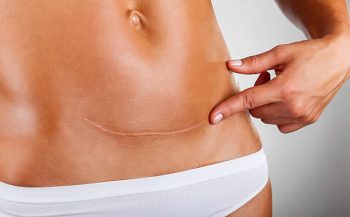Congratulations on your extra special new family member!!
The initial stages of motherhood can be daunting and sometimes there’s nothing more daunting than feeling or even looking at your cesarean section (c-section) wound for the first time. Rest assured if this is how you’re feeling – this is completely validated!! A nice way to think of the initial stages of c-section healing is to ‘make friends with your scar’. It doesn’t matter how long it takes you to do this, some friendships take longer to form than others!
What is a Caesarean Section?
Major abdominal surgery!! Yes, that’s right major. Please don’t be so hard on yourself and allow adequate time to rest and recover just as you would any other major surgery. In order to meet your baby, a c-section procedure requires 7 layers of tissue to be cut, separated and re-sutured back together. Generally, it takes a minimum of 6 weeks to recover from a c-section.
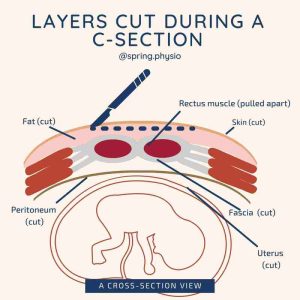
Image Credit: https://www.springphysio.co.uk/physio-blog/layers-cut-during-a-caesarean-c-section
Tips for the Early Stages of Recovery:
- Use pain relief as it is prescribed from your care team.
- Enlist support so that you can get some horizontal rest! Ideally aim for 10-15 minutes per day to help reduce swelling.
- Log roll in and out of bed (see pictures).
- Early gentle walks to help prevent complications such as blood clots and reduce swelling, pain and constipation. Ask your care team when it’s safe to do so – each situation is individual based on pain, catheterisation, complications etc.
- Use a rolled up towel or pillow to support a cough, sneeze and/or bowel movement (see pictures). You can also do this when you open your bowels.
- Adopt healthy bowel habits; avoid constipation & straining (your care provider or pelvic health physio can help with this immensely), support your tummy with a pillow, stay hydrated.
- Take care of your wound (i.e. washing, dressing changes) based on the advice of your care providers. Regularly monitor for signs of infection – pain that doesn’t settle, oozing discharge from the wound, heat and redness, fevers, itchiness. Call your care provider immediately if you suspect infection.
- Avoid heavy lifting. As a general rule of thumb don’t lift anything heavier than your baby until your care provider gives you the go ahead.
- See your pelvic health physiotherapist for advice regarding return to exercise after a c-section. At PPMP we recommend booking in to see us at 6 weeks postpartum.
- C-section massage (see below).
Log rolling:
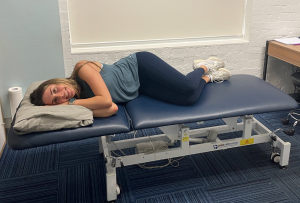
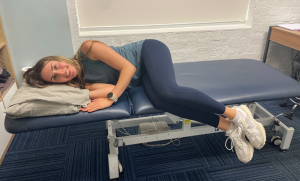
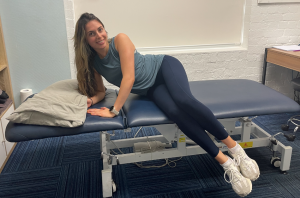
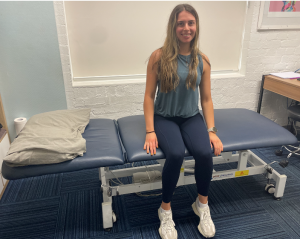
Supported cough:
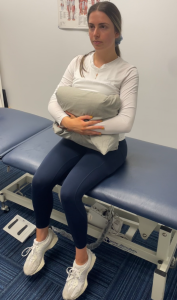
C-Section Massage:
As with any wound, as it heals it forms a new tissue made of collagen (aka scar tissue). Scar tissue is different to any other type of tissue in the body. It is rigid and firm because it doesn’t have as good a blood flow as other tissues. Since a c-section involves 7 layers of tissue healing, we want to mobilise (gently move) each of these layers to prevent adhesions, pain and numbness.
There are ample benefits of c-section massage. These include:
- Reduced sensitivity to pain and numbness.
- Increased blood flow for prompt healing.
- Prevention of adhesions and keloid scarring.
- Prevention of scar tissue in unwanted areas and abdominal organs.
- Reduced scar thickness.
- Emotionally, it helps you reconnect to your body again.
You can start scar tissue massage as soon as the wound is fully healed (generally anywhere between 4-6 weeks) or once you have clearance from your medical team. It is never too late to begin. Prior to this you can gently massage your stomach above the scar to help reduce bloating. This will also prepare the mind and body for massage over the scar once it’s healed.
To perform scar tissue massage:
Progress through each of these steps in your own time. Gently get firmer as the weeks go on, using pain/discomfort as your guide. There should be no pain/discomfort and you should be able to breathe comfortably the entire time. Pay extra attention to areas that are firm, lumpy and bumpy – spend a bit more time massaging here, you can even hold the tissue for 5-10 seconds at a time over these areas.
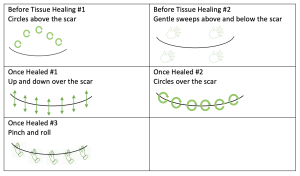
Aim for 5-10 minutes a day for best results.
Preparation:
- Check for signs of infection and ensure the scar is clean. Don’t proceed if you are worried about infection and see your care provider instead.
- Belly breathing and your favourite stretch to relax the body beforehand.
- Take a warm shower/bath or place a warm compress over the scar to help soften the tissues and relax.
- Pick a gentle moisturiser or lubricant with moisturising properties.
Before tissue healing:
- Start with little circles around your stomach.
- Gentle sweeping strokes (as if you are petting a cat) above and below the scar.
Once the tissue heals at approx 4-6 weeks (seek clearance from your care team first):
- Gently rub up and down with two fingers across the scar line in both directions.
- Rub little circles anticlockwise and clockwise over the scar to get it moving in different directions.
- Once ready, lift and roll. Pinch the skin between your finger and thumb and roll the scar between your fingers.
What else you can do to compliment the massage:
- Use postpartum compression products such as SRCs or Everform (previously known as Lenny Rose Active) recovery tights/shorts. For added comfort, you can stick a sanitary pad/liner on the inside of the tights to avoid the tights rubbing against your wound. We both these products at PMPP – some private health funds will also give you a rebate on these.
- Ask your physio or pharmacist about safe creams and ointments that they recommend for adequate wound healing. We stock Honey And Bee cream which is excellent for massage.
- Book in for a 6 week check with a women’s health physio to assess the entire core and pelvic floor!
A Final Note:
It’s not uncommon that women feel a little underprepared and left in the dark about how to recover from a c-section. If during your prenatal journey you would like more in depth information on what to expect after a c-section (from the initial stages in the hospital, to the first few weeks at home and months down the track) please book in for a physiotherapy appointment with one of our women’s health physios.
How your Physiotherapist at PMPP can help:
- Assess the firmness of the scar.
- Assist in massage techniques.
- Pain management strategies.
- Product recommendations to help with scar tissue healing.
- Reassurance, support and encouragement!
Emily Tregear
Physiotherapist/Pelvic Health
You may find these other PMPP blogs interesting:
http://Why a postnatal Physio check up is essential
https://portmelbournephysio.com.au/exercising-post-baby/
https://portmelbournephysio.com.au/for-the-new-mums/
https://portmelbournephysio.com.au/mental-health-and-pelvic-floor-dysfunction/
References – Image Credits:
1.) Gould, Dinah. “Caesarean section, surgical site infection and wound management.” Nursing Standard, vol. 21, no. 32, 18 Apr. 2007, pp. 57+. Gale OneFile: Health and Medicine, link.gale.com/apps/doc/A163332193/HRCA?u=anon~b9d8ccde&sid=googleScholar&xid=1b2d0a8e. Accessed 7 Dec. 2023.
2.) https://www.springphysio.co.uk/physio-blog/layers-cut-during-a-caesarean-c-section

